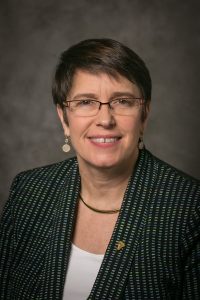A Brief Look Back at ESA in 2019
An update from Executive Director Catherine O’Riordan
Happy New Year! As ESA members and staff begin a new year in 2020, I would like to take a few minutes to reflect on a few of our accomplishments in 2019.
The ESA Governing Board led an effort to draft a new strategic plan that will guide our efforts through 2022. In addition, they have begun a review of ESA governance that has resulted in changes to modernize ESA Bylaws. These changes will help ESA to function as a modern scientific society to achieve our mission – to advance the science and practice of ecology and support ecologists throughout their careers.
Our expanded membership office has prioritized improved customer service, better implementation of our existing communication tools, and building more value into ESA membership. The office launched a new a webinar series last year, focusing on practical skills (like using NEON data, story maps, data visualization, and publishing) as well as ESA’s programs, like certification and internship opportunities. To date, nearly 1,000 people have participated in these virtual sessions, and the schedule for 2020 is filling up with additional offerings in career exploration, science communication, practical workplace skills and more.
New efforts to support section and chapter activities have been well-received. Monthly conference calls with the chairs have seen steady attendance, either live or by recording; these meetings provide chairs an opportunity to hear about ongoing work at headquarters and news from the Governing Board, and provides a discussion forum. The ECOLOG-L listserv, which ESA officially transferred to its own servers early in 2019, has continued to grow in terms of both subscribers and activity. ESA staff also keep members updated about their benefits and status by using the ECO platform, improved email strategies and the redesigned website.
The ESA Annual Meeting in Louisville, Kentucky, drew almost 2,800 participants. Plenary talks given by Karen Warkentin, Katharine Suding, and Robin Wall Kimmer were all focused on the conference theme: Bridging Communities and Ecosystems: Inclusion as an Ecological Imperative. These talks are available for viewing on the meeting website. For the 1st time, travel support was offered to those impacted by state travel bans or those who lacked institutional support to attend the conference by using funds from the Opportunity Fund. Ecology celebrated its 100th birthday at the conference, along with thanking outgoing Ecology Editor in Chief Don Strong for his years of service. We also offered a robust Career Central opportunity with sessions ranging from interview techniques to data tools, plus a “speed dating” pitch session with ESA’s editors in chief.
The National Park Leaders program was launched through ESA’s education office. This program provides internship opportunities for upper–level undergraduate and graduate students in units of the National Park Systems. Projects encompass natural and cultural resource conservation, park infrastructure, policy development, interpretation and education, and addressing management challenges arising from global drivers of environmental change.
Through support from ESA, Wiley and generous donors, the Public Affairs Office awarded 10 students the opportunity to come to Washington and learn about science policy through the Graduate Student Policy Awards.
ESA journals continue to publish highly cited content. The Impact Factor for Frontiers in Ecology and the Environment increased to over 10. Kathryn Cottingham, professor of biological sciences at Dartmouth College, has now transitioned into the role of new Editor in Chief for Ecology. She has begun her term and is revamping the Ecology editorial board to support her visio. All ESA journals now offer the gold Open Access option (Frontiers, Ecology, Ecological Applications, Ecological Monographs); the ESA Bulletin and Ecosphere remain fully open access.
The Sustaining Biological Infrastructure Training Initiative continues to provide directors of labs, collections, field stations, and digital data resources with the fundraising, communication, and strategic planning skills they need to ensure their project’s success. This year we held two Strategies for Success courses and unveiled a new 2-day business planning course.
ESA released Issue in Ecology No. 21 on Impacts to Wildlife of Wind Energy Siting and Operation in the United States. The Issue combines the expertise of 13 scientists from academia, industry, state and federal government, and conservation organizations. It summarizes what we know about the potential risks to wildlife associated with wind energy, current tactics to reduce these risks, and gaps in knowledge that call for further research.
ESA’s Panel on Vegetation Classification works to ensure the scientific rigor of the US National Vegetation Classification (USNVC). The USNVC helps land managers collaborate, manage, and identify vegetation trends on landscape, regional, and national scales. Panel members presented two webinars this year: An Introduction to the USNVC (available here), and Using Concepts and Products of the USNVC to Address Agency-Wide Business Needs (available here).
These are just a few of the many accomplishments we, as a community, achieved in 2019. I encourage you to get involved in and continue to support ESA programs– ESA is your society. Together, we can achieve even more in 2020!
